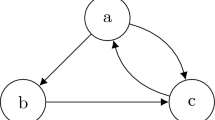Abstract
Cellular automata may be viewed as a modelization of synchronous parallel computation. Even in the one-dimensional case, they are known as capable of universal computations. The usual proof uses a simulation of a universal Turing machine. In this paper, we present how a one-dimensional cellular automata can simulate any recursive function in such a way that composition of computations occurs as soon as possible. In addition, this allows us to show that one-dimensional cellular automata may simulate asynchronous computations.
Similar content being viewed by others
References
A.J. Atrubin, An iterative one-dimensional real-time multiplier, Term Paper for App. Math. 298, Stanford University (1962).
R. Balzer, An eight-state minimal time solution to the Firing Squad Synchronization Problem, Inf. and Contr. 10(1967)22–42.
S. Cole, Real-time computation byn-dimensional arrays, IEEE Trans. Comp. 4(1969)349–365.
C. Choffrut and C. Čulik II, On real-time cellular automata and trellis automata, Actae Informaticae (1984) 393–407.
C. Čulik II, J. Gruska and A. Salomaa, Systolic treillis automaton (for VLSI), Research Report CS-81.34, Department of Computer Science, University of Waterloo (1981).
C. Čulik II, Variation of the Firing Squad Synchronization Problem, Inf. Proc. Lett. (1989) 152–157.
C. Dyer, One-way bounded cellular automata, Inf. and Contr. 44(1980)54–69.
P.C. Fisher, Generation on primes by a one-dimensional real-time iterative array, J. ACM 12(1965)388–394.
J. Mazoyer, A six-state minimal time solution to the Fring Squad Synchronization Problem, Theor. Comp. Sci. 50(1987)183–238.
J. Mazoyer, Computations on one-dimensional cellular automaton: Extended version, Preprint (1993).
J. Mazoyer and V. Terrier, Signals on one-dimensional cellular automata, Preprint.
N. Reimen and J. Mazoyer, A linear speed-up theorem for cellular automata, Theor. Comp. Sci. 101(1992)59–98.
A.R. Smith, Cellular automata theory, Technical Report 2, Stanford University (1960).
A.R. Smith, Real time language recognition by one-dimensional cellular automata, J. ACM 6(1972)233–235.
M. Minsky,Finite and Infinite Machines (Prentice-Hall, 1967) pp. 28–29.
R. Péters,Recursive Functions (Akadémiai Kiadó, Budapest, 1967).
A. Waksman, An optimal solution to the Firing Squad Synchronization Problem, Inf. and Contr. 9(1966)66–87.
Author information
Authors and Affiliations
Additional information
This work was supported by the Programme de Recherches Coordonnées Mathématiques et Informatique and the Esprit Basic Research Action “Algebraic and Syntactical Methods in Computer Science”.
Rights and permissions
About this article
Cite this article
Mazoyer, J. Computations on one-dimensional cellular automata. Ann Math Artif Intell 16, 285–309 (1996). https://doi.org/10.1007/BF02127801
Issue Date:
DOI: https://doi.org/10.1007/BF02127801



